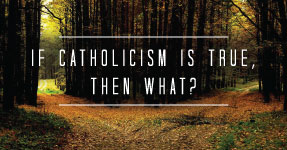Refuting the Myth Theory: 6 Reasons Why the Resurrection Accounts are True
by Dr. Peter Kreeft
Filed under The Resurrection
NOTE: Christians around the world celebrated Good Friday and Easter last week, which commemorate the death and resurrection of Jesus Christ. Thus we began a six-part series on these events by Dr. Peter Kreeft in which he examines each of the plausible theories attempting to explain what happened to Jesus at the end of his life, particularly whether he rose from the dead.
Part 1 - 5 Possible Theories that Explain the Resurrection of Jesus
Part 2 - Rejecting the Swoon Theory: 9 Reasons Why Jesus Did Not Faint on the Cross
Part 3 - Debunking the Conspiracy Theory: 7 Arguments Why Jesus’ Disciples Did Not Lie
Part 4 - Refuting the Myth Theory: 6 Reasons Why the Resurrection Accounts are True
Part 5 - Real Visions: 13 Reasons the Disciples Did Not Hallucinate
Part 6 - (Coming soon!)
We've now examined two theories attempting to explain away the resurrection of Jesus, first the "swoon" theory and then the "liar" theory. Today we'll consider perhaps the most popular alternative theory today: the "myth" theory. Many non-Christians assert that the Gospel accounts of Jesus' death and resurrection are simply myths, much like the stories we find among the Greeks and the Norse. But here are six reasons the "myth" theory does not hold:
(1) The style of the Gospels is radically and clearly different from the style of all the myths. Any literary scholar who knows and appreciates myths can verify this. There are no overblown, spectacular, childishly exaggerated events. Nothing is arbitrary. Everything fits in. Everything is meaningful. The hand of a master is at work here.
Psychological depth is at a maximum. In myth it is at a minimum. In myth, such spectacular external events happen that it would be distracting to add much internal depth of character. That is why it is ordinary people like Alice who are the protagonists of extra-ordinary adventures like Wonderland. That character depth and development of everyone in the Gospels—especially, of course, Jesus himself—is remarkable. It is also done with an incredible economy of words. Myths are verbose; the Gospels are laconic (concise).
There are also telltale marks of eyewitness description, like the little detail of Jesus writing in the sand when asked whether to stone the adulteress or not (Jn 8:6). No one knows why this is put in; nothing comes of it. The only explanation is that the writer saw it. If this detail and others like it throughout all four Gospels were invented, then a first-century tax collector (Matthew), a "young man" (Mark), a doctor (Luke), and a fisherman (John) all independently invented the new genre of realistic fantasy nineteen centuries before it was reinvented in the twentieth.
The stylistic point is argued so well by C.S. Lewis in "Modern Theology and Biblical Criticism" (in Christian Reflections and also in Fern-Seed and Elephants) that I strongly refer the reader to it as the best comprehensive anti-demythologizing essay we have seen.
Let us be even more specific. Let us compare the Gospels with two particular mythic writings from around that time to see for ourselves the stylistic differences. The first is the so-called Gospel of Peter, a forgery from around A.D. 125 which John Dominic Crossan (of the "Jesus Seminar"), insists is earlier than the four Gospels. As William Lane Craig puts it:
"In this account, the tomb is not only surrounded by Roman guards but also by all the Jewish Pharisees and elders as well as a great multitude from all the surrounding countryside who have come to watch the resurrection. Suddenly in the night there rings out a loud voice in heaven, and two men descend from heaven to the tomb. The stone over the door rolls back by itself, and they go into the tomb. The three men come out of the tomb, two of them holding up the third man. The heads of the two men reach up into the clouds, but the head of the third man reaches beyond the clouds. Then a cross comes out of the tomb, and a voice from heaven asks, 'Have you preached to them that sleep?' And the cross answers, 'Yes.'" (Apologetics, p. 189)
Here is a second comparison, from Richard Purtill:
"It may be worthwhile to take a quick look, for purposes of comparison, at the closest thing we have around the time of the Gospels to an attempt at a realistic fantasy. This is the story of Apollonius of Tyana, written about A.D. 250 by Flavius Philostratus....There is some evidence that a neo-Pythagorean sage named Apollonius may really have lived, and thus Philostratus' work is a real example of what many have thought the Gospels to be: a fictionalized account of the life of a real sage and teacher, introducing miraculous elements to build up the prestige of the central figure. It thus gives us a good look at what a real example of a fictionalized biography would look like, written at a time and place not too far removed from those in which the Gospels were written.
The first thing we notice is the fairy-tale atmosphere. There is a rather nice little vampire story, which inspired a minor poem by Keats entitled Lamia. There are animal stories about, for instance, snakes in India big enough to drag off and eat an elephant. The sage wanders from country to country and wherever he goes he is likely to be entertained by the king or emperor, who holds long conversations with him and sends him on his way with camels and precious stones.
Here is a typical passage about healing miracles: 'A woman who had had seven miscarriages was cured through the prayers of her husband, as follows. The Wise Man told the husband, when his wife was in labor, to bring a live rabbit under his cloak to the place where she was, walk around her and immediately release the rabbit; for she would lose her womb as well as her baby if the rabbit was not immediately driven away.' [Bk 3, sec 39]
The point is that this is what you get when the imagination goes to work. Once the boundaries of fact are crossed we wander into fairyland. And very nice too, for amusement or recreation. But the Gospels are set firmly in the real Palestine of the first century, and the little details are not picturesque inventions but the real details that only an eyewitness or a skilled realistic novelist can give." (Thinking About Religion, p. 75-76)
(2) A second problem is that there was not enough time for myth to develop. The original demythologizers pinned their case onto a late second-century date for the writing of the Gospels; several generations have to pass before the added mythological elements can be mistakenly believed to be facts. Eyewitnesses would be around before that to discredit the new, mythic versions. We know of other cases where myths and legends of miracles developed around a religious founder—for example, Buddha, Lao-tzu, and Muhammad. In each case, many generations passed before the myth surfaced.
The dates for the writing of the Gospels have been pushed back by every empirical manuscript discovery; only abstract hypothesizing pushes the date forward. Almost no knowledgeable scholar today holds what Rudolf Bultmann said was necessary to hold in order to believe the myth theory, namely, that there is no first-century textual evidence that Christianity began with a divine and resurrected Christ, not a human and dead one.
Some scholars still dispute the first-century date for the Gospels, especially John's. But no one disputes that Paul's letters were written within the lifetime of eyewitnesses to Christ. So let us argue from Paul's letters. Either these letters contain myth or they do not. If so, there is lacking the several generations necessary to build up a commonly believed myth. There is not even one generation. If these letters are not myth, then the Gospels are not either, for Paul affirms all the main claims of the Gospels.
Julius Müller put the anti-myth argument this way:
"One cannot imagine how such a series of legends could arise in an historical age, obtain universal respect, and supplant the historical recollection of the true character [Jesus]....if eyewitnesses were still at hand who could be questioned respecting the truth of the recorded marvels. Hence, legendary fiction, as it likes not the clear present time but prefers the mysterious gloom of gray antiquity, is wont to seek a remoteness of age, along with that of space, and to remove its boldest and most rare and wonderful creations into a very remote and unknown land." (The Theory of Myths in Its Application to the Gospel History Examined and Confuted [London, 1844], p. 26)
Müller challenged his nineteenth-century contemporaries to produce a single example anywhere in history of a great myth or legend arising around a historical figure and being generally believed within thirty years after that figure's death. No one has ever answered him.
(3) The myth theory has two layers. The first layer is the historical Jesus, who was not divine, did not claim divinity, performed no miracles, and did not rise from the dead. The second, later, mythologized layer is the Gospels as we have them, with a Jesus who claimed to be divine, performed miracles and rose from the dead. The problem with this theory is simply that there is not the slightest bit of any real evidence whatever for the existence of any such first layer. The two-layer cake theory has the first layer made entirely of air—and hot air at that.
St. Augustine refutes the two-layer theory with his usual condensed power and simplicity:
"The speech of one Elpidius, who had spoken and disputed face to face against the Manichees, had already begun to affect me at Carthage, when he produced arguments from Scripture which were not easy to answer. And the answer they [the Manichees, who claimed to be the true Christians] gave seemed to me feeble—indeed they preferred not to give it in public but only among ourselves in private—the answer being that the Scriptures of the New Testament had been corrupted by some persons unknown...yet the Manicheans made no effort to produce uncorrupted copies." (Confessions, V, 11, Frank Sheed translation)
Note the sarcasm in the last sentence. It still applies today. William Lane Craig summarizes the evidence—the lack of evidence:
"The Gospels are a miraculous story, and we have no other story handed down to us than that contained in the Gospels....The letters of Barnabas and Clement refer to Jesus' miracles and resurrection. Polycarp mentions the resurrection of Christ, and Irenaeus relates that he had heard Polycarp tell of Jesus' miracles. Ignatius speaks of the resurrection. Quadratus reports that persons were still living who had been healed by Jesus. Justin Martyr mentions the miracles of Christ. No relic of a non-miraculous story exists. That the original story should be lost and replaced by another goes beyond any known example of corruption of even oral tradition, not to speak of the experience of written transmissions. These facts show that the story in the Gospels was in substance the same story that Christians had at the beginning. This means...that the resurrection of Jesus was always a part of the story." (Apologetics, chapter 6)
(4) A little detail, seldom noticed, is significant in distinguishing the Gospels from myth: the first witnesses of the resurrection were women. In first-century Judaism, women had low social status and no legal right to serve as witnesses. If the empty tomb were an invented legend, its inventors surely would not have had it discovered by women, whose testimony was considered worthless. If, on the other hand, the writers were simply reporting what they saw, they would have to tell the truth, however socially and legally inconvenient.
(5) The New Testament could not be myth misinterpreted and confused with fact because it specifically distinguishes the two and repudiates the mythic interpretation (2 Peter 1:16). Since it explicitly says it is not myth, if it is myth it is a deliberate lie rather than myth. The dilemma still stands. It is either truth or lie, whether deliberate (conspiracy) or non-deliberate (hallucination). There is no escape from the horns of this dilemma. Once a child asks whether Santa Claus is real, your yes becomes a lie, not myth, if he is not literally real. Once the New Testament distinguishes myth from fact, it becomes a lie if the resurrection is not fact.
(6) Dr. William Lane Craig has summarized the traditional textual arguments with such clarity, condensation, and power that I'll quote him here at length. The following arguments (rearranged and outlined from Knowing the Truth About the Resurrection) prove two things: first, that the Gospels were written by the disciples, not later myth-makers, and second, that the Gospels we have today are essentially the same as the originals.
(A) Proof that the Gospels were written by eyewitnesses:
1. Internal evidence, from the Gospels themselves:
- The style of writing in the Gospels is simple and alive, what we would expect from their traditionally accepted authors.
- Moreover, since Luke was written before Acts, and since Acts was written prior to the death of Paul, Luke must have an early date, which speaks for its authenticity.
- The Gospels also show an intimate knowledge of Jerusalem prior to its destruction in A.D. 70. The Gospels are full of proper names, dates, cultural details, historical events, and customs and opinions of that time.
- Jesus' prophecies of that event (the destruction of Jerusalem) must have been written prior to Jerusalem's fall, for otherwise the church would have separated out the apocalyptic element in the prophecies, which makes them appear to concern the end of the world. Since the end of the world did not come about when Jerusalem was destroyed, the so-called prophecies of its destruction that were really written after the city was destroyed would not have made that event appear so closely connected with the end of the world. Hence, the Gospels must have been written prior to A.D. 70.
- The stories of Jesus' human weaknesses and of the disciples' faults also bespeak the Gospels' accuracy.
- Furthermore, it would have been impossible for forgers to put together so consistent a narrative as that which we find in the Gospels. The Gospels do not try to suppress apparent discrepancies, which indicates their originality (written by eyewitnesses). There is no attempt at harmonization between the Gospels, such as we might expect from forgers.
- The Gospels do not contain anachronisms; the authors appear to have been first-century Jews who were witnesses of the events.
We may conclude that there is no more reason to doubt that the Gospels come from the traditional authors than there is to doubt that the works of Philo or Josephus are authentic, except that the Gospels contain supernatural events.
2. External evidence:
- The disciples must have left some writings, engaged as they were in giving lessons to and counseling believers who were geographically distant; and what could these writings be if not the Gospels and epistles themselves? Eventually the apostles would have needed to publish accurate narratives of Jesus' history, so that any spurious attempts would be discredited and the genuine Gospels preserved.
- There were many eyewitnesses who were still alive when the books were written who could testify whether they came from their purported authors or not.
- The extra-biblical testimony unanimously attributes the Gospels to their traditional authors: the Epistle of Barnabas, the Epistle of Clement, the Shepherd of Hermes, Theophilus, Hippolytus, Origen, Quadratus, Irenaeus, Melito, Polycarp, Justin Martyr, Dionysius, Tertullian, Cyprian, Tatian, Caius, Athanasius, Cyril, up to Eusebius in A.D. 315, even Christianity's opponents conceded this: Celsus, Porphyry, Emperor Julian.
- With a single exception, no apocryphal gospel is ever quoted by any known author during the first three hundred years after Christ. In fact there is no evidence that any inauthentic gospel whatever existed in the first century, in which all four Gospels and Acts were written.
(B) Proof that the Gospels we have today are the same Gospels originally written:
- Because of the need for instruction and personal devotion, these writings must have been copied many times, which increases the chances of preserving the original text.
- In fact, no other ancient work is available in so many copies and languages, and yet all these various versions agree in content.
- The text has also remained unmarred by heretical additions. The abundance of manuscripts over a wide geographical distribution demonstrates that the text has been transmitted with only trifling discrepancies. The differences that do exist are quite minor and are the result of unintentional mistakes.
- The quotations of the New Testament books in the early Church Fathers all coincide.
- The Gospels could not have been corrupted without a great outcry on the part of all orthodox Christians.
- No one could have corrupted all the manuscripts.
- There is no precise time when the falsification could have occurred, since, as we have seen, the New Testament books are cited by the Church Fathers in regular and close succession. The text could not have been falsified before all external testimony, since then the apostles were still alive and could repudiate such tampering.
- The text of the New Testament is every bit as good as the text of the classical works of antiquity. To repudiate the textual parity of the Gospels would be to reverse all the rules of criticism and to reject all the works of antiquity, since the text of those works is less certain than that of the Gospels.
Richard Purtill summarizes the textual case:
"Many events which are regarded as firmly established historically have (1) far less documentary evidence than many biblical events; (2) and the documents on which historians rely for much secular history are written much longer after the event than many records of biblical events; (3) furthermore, we have many more copies of biblical narratives than of secular histories; and (4) the surviving copies are much earlier than those on which our evidence for secular history is based. If the biblical narratives did not contain accounts of miraculous events, biblical history would probably be regarded as much more firmly established than most of the history of, say, classical Greece and Rome." (Thinking About Religion, p. 84-85)
Related Posts
Note: Our goal is to cultivate serious and respectful dialogue. While it's OK to disagree—even encouraged!—any snarky, offensive, or off-topic comments will be deleted. Before commenting please read the Commenting Rules and Tips. If you're having trouble commenting, read the Commenting Instructions.













